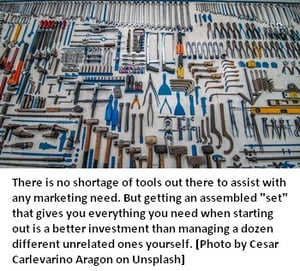
Everyone Has Been Where You Are Now
Most of the time when I am approached by a potential new client about the potential to help them with Marketing, they are almost always a small-medium business that has had some success, often with a specific product or service they started the business with that may have been an innovative product, fulfilling a previously unserved niche or by excelling for their service or pricing in an established category.
Regardless of how they started, what most of these businesses have in common is that they managed to establish themselves and become successful enough to survive their start-up years and beyond without investing much time or effort in marketing. For many of them, Sales was what got them to their current state and marketing is often not even a staffed function, but just a static website built by a vendor and occasionally updated (or not!).
If this sounds like your business, there are some do’s and don’ts to think about when you are looking to drive more growth by leveraging marketing. As your own experiences may have already exposed you to at least a few of the “don’ts”, brevity and a preference to stay forward looking here will keep me focused on the things you should do.
Seven Things You’ll Need to Grow
The list of all the things you could do, or should do, or can do is long. Like everything else in business, entire industries are devoted to making things more complicated. But like any successful part of your business, the basics matter, so start simple. Here are seven initial pieces that will be enough to get your marketing engine going:

- Invest in a Good Foundation – Like any company that has not invested in marketing over the years, you have some catching up to do. This means you will also likely face reluctance and skepticism as you go forward (in regards to budget), but your competitors who have been out there have already built a foundation upon which they have a lot to build on. You are at the point of choosing the lot where you will dig your foundation. It starts by committing to getting outside help – be it a new employee or an outside resource like an agency - is the right one. But budget matters here too. For example, if you decide to bring in a full-time Marketing Manager for $60K/yr., that marketing person will need sufficient budget to get work done to do their job (by managing an array of vendors and freelancers). But putting the same $60k into an outside agency in year one will get you a whole team of talent and all the output you need to build that foundation in year one.
- Focus on Your Desired Results – Are you looking to make a sale tomorrow or build a pipeline of leads that grows over time? Google ads are a short-term approach to quick wins. It’s a sales mentality more than a marketing mentality. While your last website re-do may be a work of art, it won’t make a sale (OK, some of them do, but don’t count on it because it varies wildly by industry and business type). Data has always shown that not only do people click less on ads in search results, they are less likely to become customers even when they do. Your money is not well spent there. Instead, focus on:
- Content – the new customers you don’t have yet don’t care about your products or history right now. But they do have problems, questions and challenges they would like help with. Focus your content on the problems your client/audience typically have and avoid making it about you. Be a giver of good information, and they will come.
- Consistency – Be consistent in putting out good, useful content. A weekly blog and some useful downloads that speak to typical challenges will gain you more leads than any amount of Google ads.
- Authority – Decide what you want to be an “authority” on and build your content around that. For our clients, the content often has nothing to do with their actual products, but more to do with the challenges their customers face every day in their own businesses. Are you selling warehouse equipment? Then content about productivity metrics and process may be a draw. Management consulting? Address the specific areas of management where you want to make the most impact.
 Content > Design and Function > Form – don’t get caught up in design discussions (and designers, don’t @ me – this is not about denying design’s value!) Your future customers don’t care. Some of the busiest web sites on the internet are also the ugliest, because Google recognizes them for what they are – useful resources. Good content means turning your org inside out (not shaking it up, just making it accessible!) for the purpose of turning all the things you do every day into great, compelling content. One common thread I’ve seen in the B2B space when we talk about marketing, especially with manufacturers and similar back office industries, is that they think what they do is too boring to make for good stories! That is NOT the case…there are hundreds of interesting stories inside ANY BUSINESS if you let the outsider on your team help you seen them!
Content > Design and Function > Form – don’t get caught up in design discussions (and designers, don’t @ me – this is not about denying design’s value!) Your future customers don’t care. Some of the busiest web sites on the internet are also the ugliest, because Google recognizes them for what they are – useful resources. Good content means turning your org inside out (not shaking it up, just making it accessible!) for the purpose of turning all the things you do every day into great, compelling content. One common thread I’ve seen in the B2B space when we talk about marketing, especially with manufacturers and similar back office industries, is that they think what they do is too boring to make for good stories! That is NOT the case…there are hundreds of interesting stories inside ANY BUSINESS if you let the outsider on your team help you seen them!- Focus on New Clients and Not Your Existing Ones – don’t let your perception of your current clients determine what you do for marketing – which is for your NEW ones. Too many orgs get bogged down in over-thinking what a specific existing client might think about an email subject or a blog title. This is something I’ve seen on the inside and outside of the client side of the business, in small start-ups and Fortune 50 companies. Keep providing the content that has impact for your future clients and don’t overthink what an existing client might think about it. Since you obviously won’t be sharing anything detrimental to their business, and if you are providing them with a solution that impacts positively, push ahead with the content that you know will be of interest to your future clients too.
- Leadership vs. Your Comfort – In a position of needing to “invest”, I’ll reiterate that what is really needed in this space is leadership – from outside. Bringing in an outside resource as noted above will go much better for you if you can find some to be your “leader” in this space and let them run. If you have not been successful to date in marketing on your own, bringing in a resource that will work under your direction will not get you where you need to be fast enough. It’s just an extension of the “hire people who are smarter than you” concept. Bring in a leader who can be given the room to run and make it work for you. Our biggest bumps are usually in the first year when the client wants to review every article, email, etc. and it just slows things down so much that results are not going to happen. We generally get them back to that comfort level once they see the results. Your best contribution as a leader in your business is to make sure the leader in Marketing has visibility and access to everything that could turn into great stories (while letting them determine what is worthy or not).
 Get the Tools You Need – We recommend and enforce use of a standardized marketing platform with our clients for a reason. In our case, it’s HubSpot, because it’s a one-stop tool for any “beginner” marketing org that takes the need to be a technology wiz out of the equation (and the wasted time and attention that usually brings). Avoid getting into a mess with 4-14 tools to save a few dollars here or there. You will waste a lot of time – and very often spend more but have less insights into your results. In the case of HubSpot, their own data shows clients do better when working with a partner (i.e. an Agency like us) than they do working on their own with HubSpot. I don’t think this is a situation unique to HubSpot. Whatever platform you use, consider my points in #1 and #5 so you aren’t spending your first year acquiring skills when you should be acquiring new leads. One other benefit? If you decide down the road you want to take things over yourself, you’ll have all of your assets and tools in one place and not have to deal with a potential nightmare of losing work product and momentum.
Get the Tools You Need – We recommend and enforce use of a standardized marketing platform with our clients for a reason. In our case, it’s HubSpot, because it’s a one-stop tool for any “beginner” marketing org that takes the need to be a technology wiz out of the equation (and the wasted time and attention that usually brings). Avoid getting into a mess with 4-14 tools to save a few dollars here or there. You will waste a lot of time – and very often spend more but have less insights into your results. In the case of HubSpot, their own data shows clients do better when working with a partner (i.e. an Agency like us) than they do working on their own with HubSpot. I don’t think this is a situation unique to HubSpot. Whatever platform you use, consider my points in #1 and #5 so you aren’t spending your first year acquiring skills when you should be acquiring new leads. One other benefit? If you decide down the road you want to take things over yourself, you’ll have all of your assets and tools in one place and not have to deal with a potential nightmare of losing work product and momentum.- Re-Examine Your Sales Org – While this is a space I usually refrain from poking too much early in a relationship, it does pay to rethink your sales organization and how it is set up to cover the future you are creating rather than the present. As your marketing begins to generate leads online, your business will be transformed. One very basic aspect that surprises many clients is that online success means you will become a national – or international Brand simply because you cannot pick where your new leads come from. Unless you are a business that is limited logistically to being local (while my favorite childhood pizza place offers FedEx of their pizzas, this is NOT the norm!), you need to consider the sales infrastructure you’ll need to allow you to accept the leads that will come to you. Maybe you once aspired to be a well-known entity in your state or county, but when that first strong lead comes in from the other side of the country, I’ve never seen anyone not get excited about becoming a national player.
Most Importantly – Get Started
Finally, the most important thing is to get things started, and then give yourself permission to let it run its course for at least a year or more. This doesn’t mean that course corrections can’t be made along the way – quite the contrary. The entire point is to keep the wheels turning and monitor and adjust along the way. Did a specific email and blog suddenly resonate much more than any previous one? Then look at expanding on that content. Did your new eBook fall flat with both new and old prospects? Maybe that means it wasn’t the kind of information they were hungry for. It’s important to put away your assumptions, anecdotal stories and historical preferences (“that’s just how things have always been done around here…”) and let the data guide you to success. It’s not easy because it is a from of letting go – but all the more reason to bring in the leadership this space needs and focus on the other core business functions you’ve prioritized until now. Your new marketing resource will need you to be a conduit for them to all of the stories and experiences your business has been keeping so that they can be shared with the outside world.




